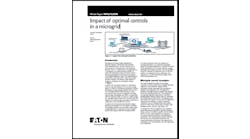Like Puerto Rico, the Hartsfield-Jackson Atlanta International Airport found out the hard way why microgrids are a good insurance policy.
The world’s busiest airport suffered an 11-hour power outage on Sunday, delaying over a thousand flights and leaving passengers stranded for hours in darkened terminals or seated in planes.
Georgia Power, the utility that serves the airport, continues to investigate what happened. But early indications are that switchgear located in an underground electrical facility failed and started a fire, according to the Southern Company subsidiary.
Posting on Twitter, stranded travelers questioned why the airport had no back-up power.
It turns out Georgia Power did have what it’s calling a “redundant” system. But that failed too because it was located close to where the fire started.
What the airport clearly lacked – and needed – is an advanced microgrid system, according to several power experts interviewed by Microgrid Knowledge.
Collapsed like dominos
The widespread blackout appears to have been the result of a series of cascading failures that caused the airport’s power system to collapse like dominos from 12:30 to 1:06 p.m.
Microgrids distributed at various locations throughout the facility, or nearby, could have prevented the cascade.
Sensing a problem almost immediately, an advanced microgrid islands or isolates itself from the faulty grid. Once safe from the problem, the microgrid’s power sources – possibly some combination of renewables, energy storage, combined heat and power or fossil fuel generators – activate to provide electricity. Advanced microgrids typically do this with barely a blip. Most travelers probably would have been unaware a problem existed had a microgrid been in operation.
Given the fire, some part of the airport probably would have still lost power, but the outage could have been contained and fixed more quickly, said Mark Feasel, a vice president at Schneider Electric.
“They can predict, prevent or mitigate faults – that is a characteristic of an advanced microgrid,” Feasel said.
Such microgrids – what Feasel referred to as microgrid 2.0 – operate with more sophisticated software and telemetary than simple back-up generators or even their earlier microgrid technology. As such, the microgrid would give the airport “the tools to detect the fault or root cause of the problem and remedy it before it snowballed,” Feasel said.
The most advanced systems integrate more than one microgrid, each backing up the other. These are sometimes called microgrid clusters. Feasel pointed to Oncor’s Texas microgrid as an example.
Airport microgrids not a novel idea
Bradley International Airport in Windsor Locks, Connecticut has a basic combined heat and power microgrid (CHP) that has supplied electricity, hot water, and chilled water since 2002. Ameresco designed, built and operates the project for the airport.
The system kept the airport powered during the notorious 2011 October Nor’easter. Also known as white Halloween, the storm dumped snow on Connecticut while the leaves were still on the trees, causing extensive power line damage. The CHP microgrid kept power flowing to the airport even as 3.2 million electric customers in 12 states lost power, some for 11 days.
Again in 2012, Bradley’s CHP system proved itself, keeping the airport up and running during Superstorm Sandy.
Learn more about the power outages in Atlanta and Puerto Rico at Microgrid 2018!
In recent years, airports and transit hubs have been getting more attention by planners and policymakers as critical sites for microgrids. This is particularly true on the disaster-prone U.S. coasts. Transit-oriented microgrids are installed or in planning in San Diego, California; Burlington, Vermont, New York City and parts of New Jersey, Maine and other states.
A microgrid was recently proposed for the California Redwood Coast-Humboldt County Airport, located in a region vulnerable to earthquakes, landslides and fires. The airport is viewed as a crucial escape route, given that the community has only two main roads that connect it to outside world.
In Maine, Brunswick Landing, a business park at a former naval air station, is also in early stages of microgrid planning. The campus includes a small general aviation airport.
In New York, the state is channeling funding to a microgrid at Amtrak’s Sunnyside Yard in Queens and Penn Station in Manhattan.
Chattanooga, Tenn., a city known for its smart grid focus, is developing a solar microgrid for its airport, one it hopes will act as a model for others.
In Denver, a microgrid serves a transit center that feeds the international airport. Longer term plans call for a much larger advanced energy system that will serve a 382-mixed use development next to the airport.
Plane flying over Atlanta, Georgia. Photo by By cate_89/Shutterstock.com
Weather, travel and airports: bad mix
“Any type of severe event such as a hurricane, or in this case a fire, can quickly create a massive power outage. Microgrids solve this problem by generating and distributing power to critical facilities, including hospitals and airports, allowing these key service-providing assets to continue operations without interruption,” said Jack Griffin, SourceOne vice president & general manager — Boston at Veolia North America.
He added: “Life safety, transportation and communications systems remain fully functional during an event because a microgrid isolates the issue and delivers an alternate path for energy production and consumption.”
“Life safety, transportation and communications systems remain fully functional …because a microgrid isolates the issue.”
Veolia’s microgrid at a Boston medical center serves as an example of how this technology can support other types of critical facilities, such as hospitals.
Beyond reliability
Justin Day, senior marketing program manager for Schweitzer Engineering Laboratories points out that while microgrids offer important energy security for airports, they also do more.
“They can also give greater efficiency to an airport’s operations during normal day-to-day activities since end users can optimize their system based on needs and available resources,” he said. “Providing value during emergencies and the routine day-to-day allows microgrids to stack their value as they contribute to an airport’s bottom line. The ability to help during planned and unplanned events make microgrids an ideal fit for any critical facility.”
During normal operations, the microgrid controller or “brain” acts as a sophisticated energy manager, determining the best mix of energy for the facility based on its goals – commonly economic, but sometimes environmental.
Power outage costs
Exactly what Georgia Power has planned – or even had in place – to ensure electric reliability at the airport remains unclear. A spokesman said that the utility is focused on the airport repairs so could not immediately answer questions about any future strategies.
[clickToTweet tweet=”No #Microgrids at the Busiest Airport in the World? ” quote=”No Microgrids at the Busiest Airport in the World?”]
What is likely, however, is an accounting of financial losses that inevitably follows this kind of disaster. Michael Bakas, executive vice president at Ameresco, pointed out in a video interview at Microgrid 2017 that another shorter and more isolated power outage at the Atlanta airport cost Delta $150 million. That outage was confined to the Delta terminal and lasted for five hours.
In the past airports and other large facilities sometimes shied from microgrid development because they lacked funding to make the capital expenditure. But Don Wingate, a Schneider Electric vice president pointed out in an interview that new business models take away the financial hit. Under what’s known as microgrid-as-a-service or MaaS, a third party finances, owns and operates the microgrid, and the microgrid customer just pays for the service, much as they pay their electric utility. This removes the need for the microgrid customer to make a large upfront expenditure for the microgrid installation.
In Puerto Rico, Hurricane Maria wiped out the entire island’s electric grid. After the fact the island is aggressively looking at ways to invest in microgrids. A plan is now on the table to rebuild with microgrids at a cost of about $1 billion.
The Atlanta airport outage may prove to be a similar wake up call for North America’s transportation facilities. Both Atlanta and Puerto Rico are learning that the economic and human hardship of failing to secure power outage insurance – a microgrid – before the lights go out.
Track news about microgrids. Subscribe to the free Microgrid Knowledge newsletter.








